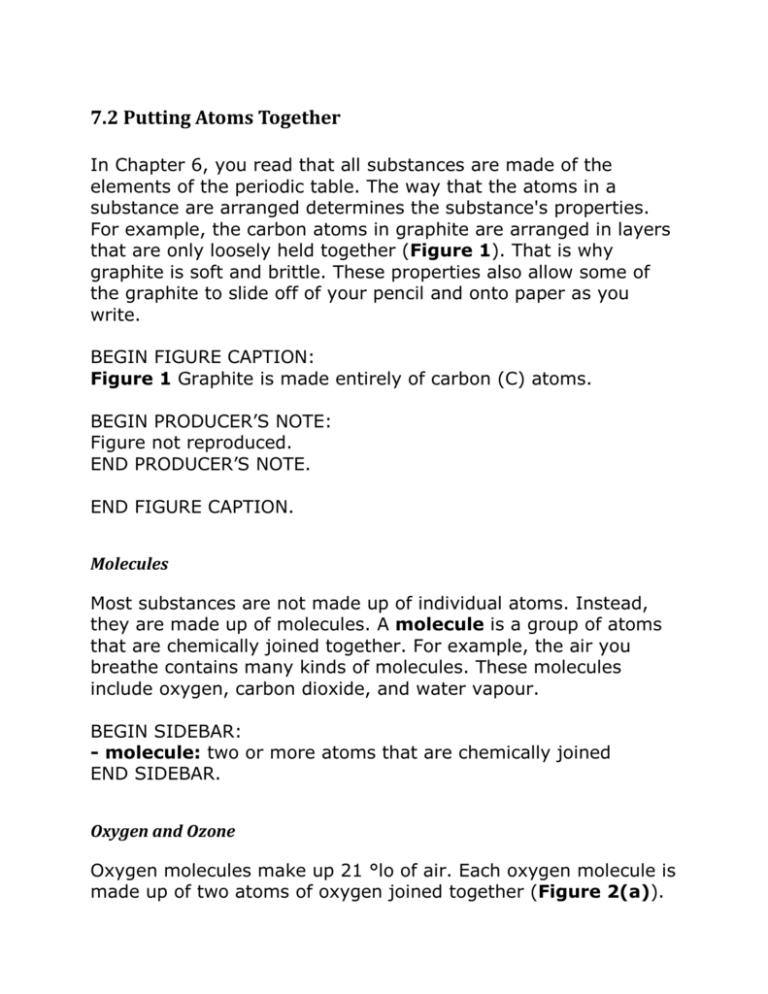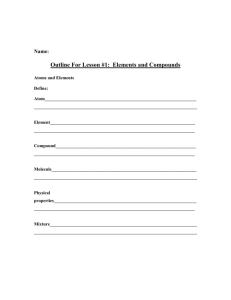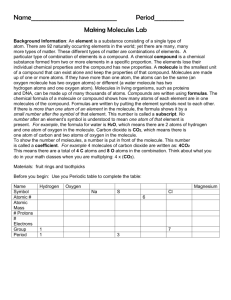7.2 Putting Atoms Together
advertisement

7.2 Putting Atoms Together In Chapter 6, you read that all substances are made of the elements of the periodic table. The way that the atoms in a substance are arranged determines the substance's properties. For example, the carbon atoms in graphite are arranged in layers that are only loosely held together (Figure 1). That is why graphite is soft and brittle. These properties also allow some of the graphite to slide off of your pencil and onto paper as you write. BEGIN FIGURE CAPTION: Figure 1 Graphite is made entirely of carbon (C) atoms. BEGIN PRODUCER’S NOTE: Figure not reproduced. END PRODUCER’S NOTE. END FIGURE CAPTION. Molecules Most substances are not made up of individual atoms. Instead, they are made up of molecules. A molecule is a group of atoms that are chemically joined together. For example, the air you breathe contains many kinds of molecules. These molecules include oxygen, carbon dioxide, and water vapour. BEGIN SIDEBAR: - molecule: two or more atoms that are chemically joined END SIDEBAR. Oxygen and Ozone Oxygen molecules make up 21 °lo of air. Each oxygen molecule is made up of two atoms of oxygen joined together (Figure 2(a)). A chemical formula is used to describe the number and type of atom in each substance. The chemical formula for an oxygen molecule is O2. The subscript, 2, tells you that there are two atoms of oxygen in each molecule of oxygen. BEGIN SIDEBAR: - subscript: the small number that follows the symbol for an element in a chemical formula and shows how many atoms of the element are present END SIDEBAR. Oxygen can also be found as O3 molecules. This type of oxygen has a special name: ozone (Figure 2(b)). Because O2 and O3 molecules are put together differently, these substances have different chemical and physical properties. Your body breathes in O2 molecules to survive. O3, on the other hand, is toxic and highly reactive. Inhaling ozone damages lung tissue. BEGIN FIGURE CAPTION: Figure 2 (a) An oxygen molecule (O2) consists of two oxygen atoms joined together. (b) An ozone molecule (O3) consists of three oxygen atoms. BEGIN PRODUCER’S NOTE: Figure not reproduced. END PRODUCER’S NOTE. END FIGURE CAPTION. BEGIN SIDEBAR: DIG DEEPER! Did You Know? The Good and Bad of Ozone Ozone high in the atmosphere protects Earth by absorbing harmful UV radiation from the Sun. Near Earth's surface, ozone is an irritating air pollutant in smog. END SIDEBAR. PRINT PAGE 249 Molecular Elements Like an oxygen atom, a molecule of oxygen is also an element. Oxygen is an element that occurs as molecules. There are two different kinds of oxygen molecules, O2 and O3. Hydrogen (H2) and phosphorus (P4) are other examples of elements that occur as molecules (Figure 3). BEGIN FIGURE CAPTION: Figure 3 This diver is using a torch that burns hydrogen gas (H2) with a flame so hot that the torch can be used effectively underwater. BEGIN PRODUCER’S NOTE: Figure not reproduced. END PRODUCER’S NOTE. END FIGURE CAPTION. There are seven elements that form molecules consisting of two atoms: H2, N2, O2, F2, Cl2, Br2, and I2. A molecule that contains two atoms is sometimes called "diatomic." The prefix di- means "two." BEGIN SIDEBAR: DIG DEEPER! Learning Tip Understanding Molecular Models In these molecular models, the white spheres represent hydrogen atoms, the black spheres represent carbon atoms, the red spheres represent oxygen atoms, and the blue spheres represent nitrogen atoms. END SIDEBAR. Compounds Other than oxygen (O2) and nitrogen (N2) in air, it is rare to find elements on their own. Most of the pure substances we come across contain more than one element. Water, for example, is made up of two different elements-hydrogen (H) and oxygen (O). A pure substance that contains two or more elements is called a compound. The chemical formula for the compound water is H2O. That means that each molecule of water has two H atoms and one O atom. The formula for water is read H-2-O. Note that the subscript 1 is not written. Figure 4 shows models of three compounds found in the air. BEGIN SIDEBAR: - compound: a pure substance made up of two or more elements that are chemically joined END SIDEBAR. BEGIN FIGURE CAPTION: Figure 4 (a) Water (H2O) is made of two hydrogen (H) atoms and one oxygen (O) atom. (b) Carbon dioxide (CO2) is made of one carbon (C) atom and two oxygen (O) atoms. (c) Nitric oxide (NO) is made of one nitrogen (N) atom and one oxygen (O) atom. BEGIN PRODUCER’S NOTE: Figure not reproduced. END PRODUCER’S NOTE. END FIGURE CAPTION. PRINT PAGE 250 Interpreting Formulas A chemical formula tells you important information about a pure substance. - The symbols in the formula tell you the elements in the substance. - If there is only one symbol, the substance is an element. - If there is more than one symbol, the substance is a compound. - The subscripts tell you how many atoms of each element are in each molecule of the substance. BEGIN TEXTBOX: SAMPLE PROBLEM: Interpreting Chemical Formulas Interpret the chemical formula for sodium carbonate (Na2CO3). Step 1: Determine how many different elements are in the formula. - Sodium carbonate contains 3 elements: Na, C, and O. Step 2: Determine how many atoms of each element are in the formula. - Na2CO3 is made up of Na2, C, and O3, so Na2CO3 has 2 atoms of sodium (Na) 1 atom of carbon (C) and 3 atoms of oxygen (O). Step 3: Determine the total number of atoms in the chemical formula. - 2 Na atoms + 1 C atom + 3 O atoms = 6 atoms There are 6 atoms in the formula for sodium carbonate. Practice: Interpret the formulas of these common compounds: (a) ammonia (NH3) (b) butane (C4H10) END TEXTBOX. 7.2 Wrap Up - Elements are pure substances that contain only one type of atom. They are represented by the chemical symbols found in the periodic table. - Compounds are pure substances made up of two or more elements. - Atoms can chemically join together to form larger units called molecules. - Molecules may contain atoms of different elements or atoms of the same element. - Chemical formulas state the type and number of atoms in each molecule of a pure substance. BEGIN TEXTBOX: CHECK YOUR LEARNING 1. In your own words, explain how a compound and a molecule are alike and how they are different. K/U, C 2. Classify each of the following as an element or a compound. K/U (a) O3 (b) KCl (c) NO (d) MgCl2 (e) Fe (f) Cl2 3. Which part of Figure 5 represents the following? K/U (a) a compound (b) an element that exists as diatomic molecules (c) individual atoms of an element BEGIN FIGURE CAPTION: Figure 5 BEGIN PRODUCER’S NOTE: Figure not reproduced. END PRODUCER’S NOTE. END FIGURE CAPTION. 4. (a) What information do the subscripts in the chemical formulas O2 and O3 provide? (b) How do the properties of these forms of oxygen differ? K/U 5. Interpret each of these chemical formulas. K/U (a) F2 (b) C3H8 (c) KBr (d) CaCO3 (e) HCI (f) CH4 (g) AgNO3 (h) Fe2O3







